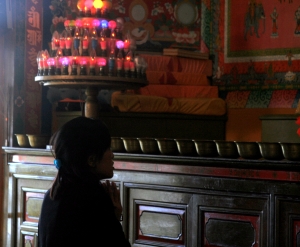The all-too-familiar and much-loved smell of burnt juniper leaves welcomes you to the Choe-khang or prayer room of any Tibetan home — the oasis of any Tibetan.
 Inside, the gods and goddesses of Tibet look down at you from beautifully hand-painted Thangkas, where some assume peaceful expressions, while others appear more wrathful. They also smile at you from gold-painted statues that have been adorned with silk and precious stones.
Inside, the gods and goddesses of Tibet look down at you from beautifully hand-painted Thangkas, where some assume peaceful expressions, while others appear more wrathful. They also smile at you from gold-painted statues that have been adorned with silk and precious stones.
Each statue is placed in the altar in the order of their importance, with the main statue of the Buddha either in the center or at the beginning of the line. At the foot of this comforting sight of the gold-plated statues are seven silver bowls of water offerings or yonjop, an offering made every morning and taken down before sunset. Between these bowls of water offerings are butter lamps, their flames illuminating the faces of the Gods, as if infusing life into the statues and willing them to assume a human form. At the end of the seven bowls of water offerings is a small bowl filled with tea — another daily offering of the first drops of tea for that day, following which the tea is finally served to members of the family.
Next to the altar is a wooden case with rows of pejas or Tibetan scriptures neatly stacked one atop another. At the end of the altar is a yang-gam or a chest of treasures/fortune.
Amid all of these treasures of Tibetan Buddhism, you can’t help but feel at peace — with the world, with yourself — each time you step into a Tibetan Choe-khang.
3 thoughts on “Choe-khang or prayer house, a Tibetan’s oasis”